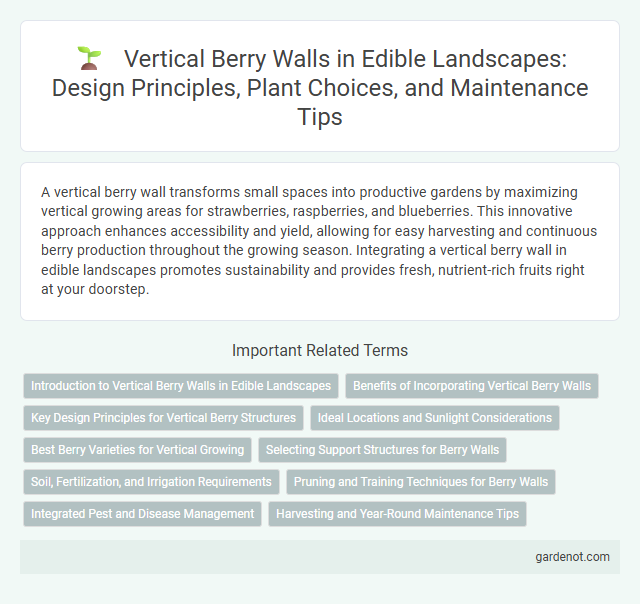A vertical berry wall transforms small spaces into productive gardens by maximizing vertical growing areas for strawberries, raspberries, and blueberries. This innovative approach enhances accessibility and yield, allowing for easy harvesting and continuous berry production throughout the growing season. Integrating a vertical berry wall in edible landscapes promotes sustainability and provides fresh, nutrient-rich fruits right at your doorstep.
Introduction to Vertical Berry Walls in Edible Landscapes
Vertical berry walls transform small spaces by integrating fruit-bearing plants into vertical structures, maximizing yield per square foot. These living walls enhance garden aesthetics while providing easy access to fresh berries such as strawberries, raspberries, and blueberries. Engineered for optimal sunlight exposure and air circulation, vertical berry walls offer sustainable, efficient solutions for urban edible landscapes.
Benefits of Incorporating Vertical Berry Walls
Vertical berry walls maximize limited garden space by allowing multiple berry plants to grow upwards, increasing yield per square foot. They improve air circulation around plants, reducing the risk of fungal diseases and promoting healthier growth. Incorporating vertical structures also enhances ease of harvesting and maintenance, making berry production more efficient and accessible.
Key Design Principles for Vertical Berry Structures
Vertical berry walls maximize space using sturdy, moisture-resistant frameworks that support healthy plant growth and fruit production. Incorporating proper drainage systems and selecting lightweight, nutrient-rich growing mediums optimize root health and yield. Strategic orientation toward sunlight exposure and access for easy harvesting enhance berry quality and maintenance efficiency in edible landscape designs.
Ideal Locations and Sunlight Considerations
A vertical berry wall thrives in locations receiving at least 6 to 8 hours of direct sunlight daily, ensuring optimal fruit production and plant health. Ideal sites include south-facing walls or fences that provide consistent warmth and protect plants from harsh winds. Proper sunlight exposure promotes vigorous growth and maximizes berry yield on the vertical structure.
Best Berry Varieties for Vertical Growing
Raspberry, blackberry, and blueberry varieties are ideal for vertical berry walls due to their strong canes and compact growth habits. Thornless raspberry cultivars such as 'Heritage' and 'Autumn Bliss' thrive in vertical setups, providing high yields and ease of maintenance. Blueberries like 'Top Hat' and 'Jelly Bean' offer dwarf growth perfect for limited space, while trailing raspberry varieties add lush greenery and abundant fruit along vertical trellises.
Selecting Support Structures for Berry Walls
Choosing durable and weather-resistant support structures is essential for vertical berry walls to ensure healthy plant growth and ease of harvest. Materials like galvanized steel, untreated cedar, and UV-resistant trellis netting provide strong frameworks that withstand outdoor conditions while supporting heavy berry-laden branches. Proper spacing and anchoring of these supports enhance air circulation and sunlight exposure, promoting higher yields in edible landscape designs.
Soil, Fertilization, and Irrigation Requirements
Optimal soil for a vertical berry wall is well-draining, loose loam enriched with organic matter to support root aeration and moisture retention. Fertilization should incorporate balanced, slow-release fertilizers high in nitrogen, phosphorus, and potassium to promote healthy foliage and fruit development. Irrigation requires consistent moisture through drip systems to prevent water stress while avoiding waterlogging, ensuring uniform hydration across all vertical layers.
Pruning and Training Techniques for Berry Walls
Pruning and training techniques for vertical berry walls enhance fruit production and plant health by promoting optimal sunlight exposure and air circulation. Regularly removing dead or overcrowded branches encourages new growth and improves berry size and quality. Using trellises or wire supports directs vine growth vertically, maximizing space efficiency and ease of harvest in edible landscapes.
Integrated Pest and Disease Management
Vertical berry walls employ Integrated Pest and Disease Management (IPDM) strategies to maintain healthy plant growth by combining biological controls, such as beneficial insects, with organic treatments that minimize chemical use. Regular monitoring and early identification of pests and diseases enable targeted interventions, reducing damage and promoting sustainable yield. This approach enhances berry production on limited space while preserving the ecological balance of the edible landscape.
Harvesting and Year-Round Maintenance Tips
Harvesting ripe berries from a vertical berry wall requires gentle plucking to avoid damaging delicate stems and encourages continuous fruit production. Regular pruning and monitoring for pests and diseases ensure healthy growth and sustain high yields throughout the year. Consistent watering and fertilization tailored to berry plants promote vigorous growth and prolong the harvest season in vertical gardens.
Vertical berry wall Infographic

 gardenot.com
gardenot.com